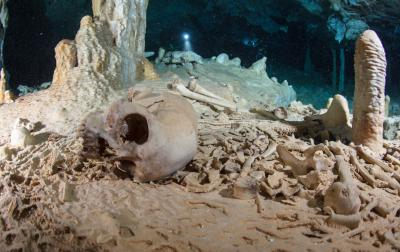
PLOS—Analysis of a skeleton found in the Chan Hol cave near Tulum, Mexico suggests human settlement in the Americas occurred in the late Pleistocene era, according to a study* published August 30, 2017 in the open-access journal PLOS ONE by Wolfgang Stinnesbeck from Universität Heidelberg, Germany, and colleagues.
Scientists have long debated about when humans first settled in the Americas. While osteological evidence of early settlers is fragmentary, researchers have previously discovered and dated well-preserved prehistoric human skeletons in caves in Tulum in Southern Mexico.
To learn more about America’s early settlers, Stinnesbeck and colleagues examined human skeletal remains found in the Chan Hol cave near Tulum. The researchers dated the skeleton by analyzing the Uranium, Carbon and Oxygen isotopes found in its bones and in the stalagmite which had grown through its pelvic bone.
The researchers’ isotopic analysis dated the skeleton to ~13 k BP, or approximately 13,000 years before present. This finding suggests that the Chan Hol cave was accessed during the late Pleistocene, providing one of the oldest examples of a human settler in the Americas. While the researchers acknowledge that changes in climate over time may have influenced the dating of the skeleton, future research could potentially disentangle how climate impacted the Chan Hol archaeological record.
________________________________
A prehistoric human skeleton in the Chan Hol Cave near Tulúm on the Yucatán peninsula prior to looting by unknown cave divers. Credit: Tom Poole, Liquid Junge Lab
_________________________________________
Article Source: PLOS ONE news release
__________________________________________
*Stinnesbeck W, Becker J, Hering F, Frey E, González AG, Fohlmeister J, et al. (2017) The earliest settlers of Mesoamerica date back to the late Pleistocene.
__________________________________________
Receive 30 days free access to the popular new CuriosityStream lineup of documentaries on science, history, nature, and technology as a new Popular Archaeology premium subscriber.
___________________________________________
Travel and learn with Far Horizons.
____________________________________________
This richly illustrated issue includes the following stories: Recent findings shedding new light on the whereabouts of the remains of Philip of Macedon, father of Alexander the Great; how an archaeologist-sculptor is bringing bones of the dead back to life; archaeologists uncovering town life at the dawn of civilization; an exclusive interview with internationally acclaimed archaeologist James M. Adovasio about what makes the Meadowcroft Rockshelter prominent in the ongoing search for the first Americans; what archaeologists are finding at the site of the ancient city of Gath, the home town of the biblical Philistine giant, Goliath; and how scientists are redrawing the picture of human evolution in Europe. Find it on Amazon.com.








